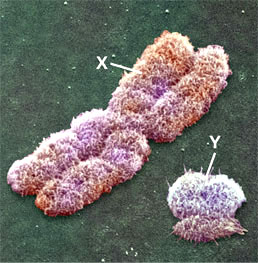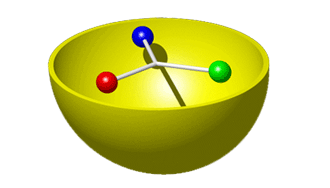Complexity
![]()
 This concept
is a scientific theory which
asserts that some systems display behavioral characteristics that are completely inexplicable
by any conventional analysis of that systems' separate, discretely acting, constituent parts.
This concept
is a scientific theory which
asserts that some systems display behavioral characteristics that are completely inexplicable
by any conventional analysis of that systems' separate, discretely acting, constituent parts.
"The relative proportion of atoms is only part of what defines our bodily structure. Bodies are organized like a set of Russian nesting dolls: tiny particles make atoms, groups of atoms make molecules, and molecules assemble and interact in different ways to compose our cells, tissues, and organs. Each level of organization brings new properties that are greater than the sum of its parts. . . .Hierarchical architecture, smaller things making larger entities with new defining properties, is the basic way our world is organized and ultimately reveals our deepest connections to the universe, the solar system and planet."
The story of our life on earth is not simple
Defining terms | A first step | A second step | Defining complex adaptive systems | Earth is complex | Sources | Complex | Complexity | Science
Complexity is a way of seeing physical, chemical, geological, genetic, and biological existence as interdependent and related in a specific order or specified protocol that is so interlinked that each level of material integration sustains the other in a decisive manner.
"These phenomena, commonly referred to as emergent behavior, seem to occur in many complex systems involving living organisms, such as [ a school of fish, a herd of bison, a pod of whales ] a stock market or the human brain. For instance, complexity theorists see a stock market crash as an emergent response of a complex monetary system to the actions of myriad individual investors; human consciousness is seen as an emergent property of a complex network of neurons in the brain."
Evolution by means of natural selection, is an example of a process driven by emergent properties.
"Precisely how to model such emergence --that is, to devise mathematical laws that will allow emergent behavior to be explained and even predicted-- is a major problem that has yet to be solved by complexity theorists.
The effort to establish a solid theoretical foundation has attracted mathematicians, physicists, biologists, economists, and others, making the study of complexity an exciting and evolving new scientific theory."
So says the Encyclopedia Britannica.
![]()
As science journalist, Horace Freeland Judson suggests, "Scientists are building explanatory structures, telling stories which are scrupulously tested to see if they are stories about real life."
He writes that "Because of new information, we change the ways in which we view the world. We are not so much the center of things any more, because of science. We feel lost, or at least not yet found. We are not as informed about our role in the universe as we thought we were a few centuries ago."
The first giant step into complexity
came with the works of Charles Darwin in ethology, evolutionary biology and ecology:
![]() "whilst
this planet has gone cycling on according to the fixed law of gravity, from
so simple a beginning endless forms most beautiful & most wonderful have
been and are being evolved."
"whilst
this planet has gone cycling on according to the fixed law of gravity, from
so simple a beginning endless forms most beautiful & most wonderful have
been and are being evolved."
Charles Darwin, The Origin of Species, p. 417
![]()
 The
second giant step into complexity
The
second giant step into complexity
came with the works of nuclear physics and atomic scientists.
Murray Gell-Man, the Cal Tech physicist who conceived of quarks, has said that:
"You know, frequently a theorist will even throw out a lot of data on the grounds that if they don't fit an elegant scheme, they're wrong."
A cartoon diagram of quarks in a subatomic particle.
A complex
adaptive system
"But biological evolution itself can also be described as a complex adaptive system, even in the humblest organisms."
(Gell-Mann, page 61.)
"In the course of biological evolution, random changes take place in the genotype from generation to generation."
( Gell-Mann, p. 65.)
""In entering the realm opened up by the gateway event, an organism acquires new and very significant regularities, which raise it to a higher level of complexity." "In the evolution of an ecological community for an economy or a society, opportunities for increased complexity keep arising, as they do in biological evolution, and the result is a tendency for the maximum complexity to drift upward."
(Gell-Mann, page 241.)
"Cooperation leading to aggregation can be effective."
(Gell-Mann, page 242.)
The trend toward higher complexity --- may be inexorable
"The opening of a critical gateway results in an explosion of ecological niches, the filling of which may well look as if it were caused by a drive toward greater complexity."
"Our effect on the biosphere is so profound and our ability to transform life will soon be so great that the future of life on Earth really does depend in large part on crucial choices made by our species."
"One general difficulty becomes apparent when we introduce the crude notion of a 'fitness landscape.' Imagine the different genotypes to be laid out on a horizontal two-dimensional surface."
( Gell-Mann, page. 249.)
"The conservation of nature, safeguarding as much biological diversity as possible is urgently required…."
( Gell-Mann, p. 375.)
Murray Gell-Mann, The Quark and the Jaguar.
![]()
What we need to conserve is the capacity for complexity on which life thrives.
"A critical insight of modern biology is that our family history extends to all other living things."
That is life and the conditions under which or within which all life thrives are not a simple milieu; instead there persists an unbroken chain of contingent linkages such that "We can follow this logic to add species after species and find the family tree that relates people, fish, and flies to the millions of other species on the planet."
Neil Shubin, (2013), p. 17.
In fact we are all stardust that shines back into a staggering variety of related forms of life.
“The planet called Earth is a very unusual cosmic body.…Earth, however is anomalous.… a relatively tiny habitable sphere, suspended in the black emptiness of the heavens, hurtling at 30 kilometers a second in captive and delicately balanced orbit around the life giving but potentially lethal sun.”
Preston Cloud, Cosmos, Earth, and Man, p. 1.
"We seem helpless in the face of our own ability to devastate the globe."
E. M. Thomas, The Third Chimpanzee."We are intimately bound up with the rest of Nature.”
Carl Sagan, Cosmos, p. xii
Sources:
Carl Sagan
Fritjof Capra, Web of life. New York: Anchor Books, 1996. pp. 223-303.
Murray Gell-Mann, The Quark and the Jaguar, New York: 1998.
Neil Shubin, The Universe Within: The Deep History of the Human Body, New York: Vintage Books, 2013.